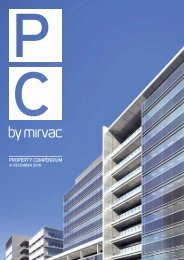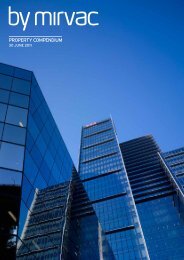MIRVAC gRoup AnnuAl RepoRt 2012 - Mirvac - Mirvac Group
MIRVAC gRoup AnnuAl RepoRt 2012 - Mirvac - Mirvac Group
MIRVAC gRoup AnnuAl RepoRt 2012 - Mirvac - Mirvac Group
You also want an ePaper? Increase the reach of your titles
YUMPU automatically turns print PDFs into web optimized ePapers that Google loves.
CoRpoRAte goVeRnAnCe stAteMent<br />
1 intRoDuction<br />
This section of the Annual Report outlines <strong>Mirvac</strong>’s<br />
governance framework.<br />
<strong>Mirvac</strong> is committed to ensuring that its systems, procedures<br />
and practices reflect a high standard of corporate<br />
governance. The Directors believe that <strong>Mirvac</strong>’s corporate<br />
governance framework is critical in maintaining high<br />
standards of corporate governance and fostering a culture<br />
that values ethical behaviour, integrity and respect to protect<br />
securityholders’ and other stakeholders’ interests at all times.<br />
During the year ended 30 June <strong>2012</strong>, <strong>Mirvac</strong>’s corporate<br />
governance framework was consistent with the Corporate<br />
Governance Principles and Recommendations released<br />
by the ASX Corporate Governance Council in August<br />
2007 (“Recommendations”) which were updated in<br />
2010. The table on pages 37 and 38 indicates where<br />
specific Recommendations are dealt with in this<br />
corporate governance statement. In accordance with the<br />
Recommendations, copies of the <strong>Group</strong> policies referred to<br />
in this corporate governance statement are posted to<br />
<strong>Mirvac</strong>’s website: www.mirvac.com/corporate-governance.<br />
2 pRinciple 1: lAy soliD founDAtions foR<br />
MAnAgeMent AnD oveRsight<br />
a) Responsibilities of the board and management<br />
i) primary objective of Board<br />
The primary objective of the Board is to build long-term<br />
securityholder value with due regard to other stakeholder<br />
interests. The Board does this by setting strategic direction<br />
and context, such as <strong>Mirvac</strong>’s mission, vision and values, and<br />
focusing on issues critical for its successful execution such<br />
as personnel, performance and the management of risk.<br />
The Board is also responsible for overseeing <strong>Mirvac</strong>’s<br />
corporate governance framework.<br />
ii) Board Charter<br />
In order to promote high standards of corporate governance<br />
and to clarify the role and responsibilities of the Board,<br />
the Board has formalised its roles and responsibilities into<br />
a Board Charter. The Board Charter sets out the Board’s<br />
accountabilities and responsibilities, including strategy and<br />
planning, personnel, remuneration, capital management<br />
and financial reporting, performance monitoring, risk<br />
management, audit and compliance, progress in relation<br />
to the <strong>Group</strong>’s diversity objectives and compliance with its<br />
diversity policy and Board processes and policies. The Board<br />
Charter was reviewed and updated during 2011.<br />
Non-executive Directors spend approximately 25 to 30<br />
days each year on Board activities and business, including<br />
attendance at Board meetings, Board committee meetings,<br />
strategy and budget meetings with management, visits<br />
to interstate sites and meetings with <strong>Mirvac</strong> stakeholders.<br />
During the year ended 30 June <strong>2012</strong>, the Board visited <strong>Mirvac</strong><br />
offices and sites in Brisbane, Melbourne, wA and Sydney.<br />
The Non-executive Directors meet regularly without the<br />
presence of management, to discuss the operation of the<br />
Board and a range of other matters. Relevant matters arising<br />
from these meetings are shared with the full Board.<br />
28 mirvac group annual report <strong>2012</strong><br />
The Managing Director provides open and detailed reports<br />
on <strong>Mirvac</strong>’s performance and related matters to each Board<br />
meeting. The Chief Financial officer also provides open and<br />
comprehensive reports on <strong>Mirvac</strong>’s financial performance<br />
and other relevant matters such as <strong>Mirvac</strong>’s debt position and<br />
the status of <strong>Mirvac</strong>’s financing facilities. The Board monitors<br />
the decisions and actions of the Managing Director and the<br />
performance of the <strong>Group</strong> to gain assurance that progress is<br />
being made towards attainment of the approved strategies<br />
and plans. The Board also monitors the performance of the<br />
<strong>Group</strong> through its Board committees.<br />
A copy of the Board Charter is available on the <strong>Group</strong>’s<br />
website: www.mirvac.com/corporate-governance.<br />
iii) Delegation to Managing Director and senior executives<br />
The Board Charter delegates responsibility for the day<br />
to day management and administration of the <strong>Group</strong> to<br />
the Managing Director, assisted by the eLT. The Managing<br />
Director and senior executives of the <strong>Group</strong> operate in<br />
accordance with Board-approved policies and limits of<br />
delegated authority.<br />
iv) elt<br />
The eLT was formed by the Board and is governed by the<br />
eLT Charter. The eLT Charter sets out the responsibilities<br />
and accountabilities of the eLT and the delegated authority<br />
of the Board which may be exercised by the eLT. The terms<br />
of the eLT Charter specify the membership of the eLT,<br />
which at 30 June <strong>2012</strong> comprised the Managing Director,<br />
the Chief Financial officer, the Chief operating officer,<br />
the Chief executive officer — Investment and the Chief<br />
executive officer — Development. A copy of the eLT Charter<br />
is available on the <strong>Group</strong>’s website: www.mirvac.com/<br />
corporate-governance.<br />
All senior executives have their position descriptions,<br />
roles and responsibilities set out in writing, either in their<br />
employment contract or as part of the performance<br />
management system.<br />
v) evaluation of performance of senior executives<br />
The performance of senior executives is reviewed on an<br />
annual cycle, with an interim six monthly review. This is<br />
part of <strong>Mirvac</strong>’s performance management system, which<br />
is in place for all <strong>Mirvac</strong> employees. The performance<br />
management system comprises a series of key performance<br />
indicators (“KPI”) which are aligned to <strong>Mirvac</strong>’s strategic<br />
objectives. Performance is measured against the agreed<br />
KPI and against consistency of senior executives’ behaviour<br />
against the agreed <strong>Mirvac</strong> corporate values.<br />
on an annual basis, the Chairman and the Board review<br />
the performance of the Managing Director, following a<br />
review by the hRC. The Managing Director is assessed<br />
against qualitative and quantitative criteria, including profit<br />
performance of <strong>Mirvac</strong> and achievement of other measures,<br />
including safety performance and alignment of <strong>Group</strong><br />
performance to strategic objectives. In turn, the Managing<br />
Director reviews the performance of his direct reports<br />
against their agreed KPI, which are reviewed by the hRC.<br />
A performance evaluation of all senior executives and<br />
the Managing Director took place during the year ended<br />
30 June <strong>2012</strong> in accordance with the process referred to<br />
above. Further information on performance evaluation and<br />
remuneration (including assessment criteria) is set out in the<br />
remuneration report starting on page 08.




